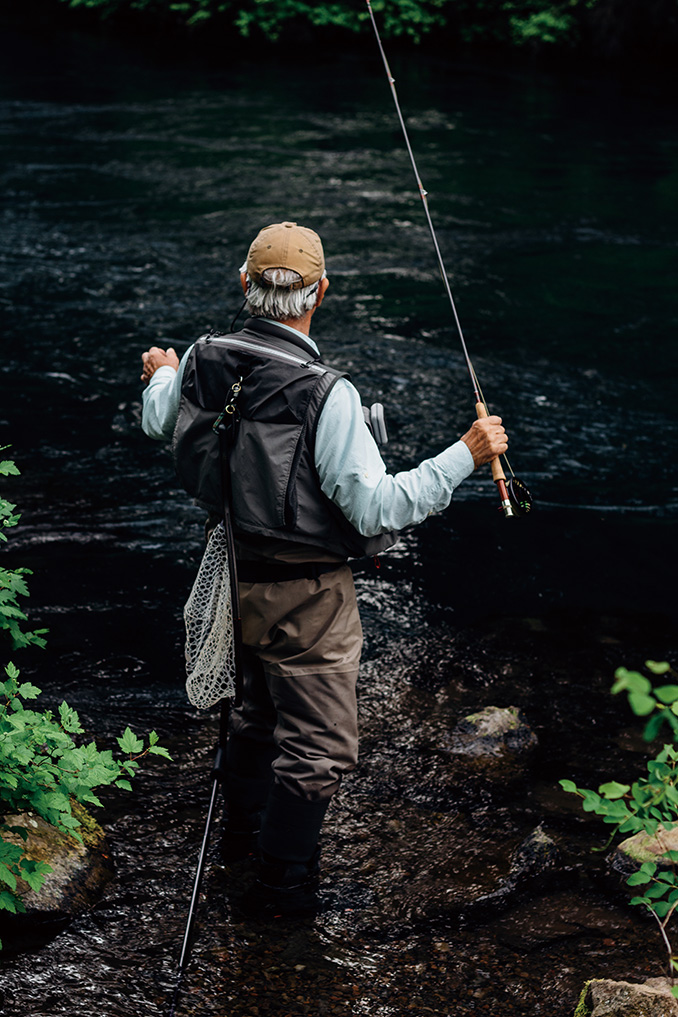
一所出类拔萃的学校应该要像一个捕鱼专家那样。
文:Marcel G. Gauthier(上海美国学校校长)
译:顾峥清(香港大学艺术史和英文双主修大二在读)
图:Unsplash
我想知道你们当中有没有人曾经尝试过钓鳟鱼。不是在上海及周边的河道里钓鱼,而是去野外干净清冽的山泉里捕鱼。
如果你们从来没有尝试过,可以看看一部叫《大河恋》的美国电影,布拉德·皮特由此大放异彩。在这部优美而伤感的电影里,钓鳟鱼这项活动扮演着重要角色。
我想指出的是钓鳟鱼是一门科学,同时它也是一门艺术。为什么?因为鳟鱼很难抓到,它们挑剔又聪明。它们不会落网,除非我们能够让它们坚信鱼饵是真实的。
我曾经在美国西部山区短暂生活过一段时间,那时我开始把钓鳟鱼作为一种爱好——身处大自然的同时学习一项新技能,这看起来是一举两得的好差事。如果运气好,我也许还可以收获晚餐的食材。
所以我以年轻人的激情开始学习钓鱼,买了很多昂贵的器材,在网上读了一两篇文章,开车到山间小溪,信心满满地认为鳟鱼一定会很期待我的到来、迫不及待地想要跟我回家。
结果它们没有。
我确实可以看到清亮的溪水里有鳟鱼在朝上游不停摇摆,但是我很快就意识到它们不是为我而生的。
钓鱼的时候会用一只人造飞虫,把它扔向水面,以此吸引鳟鱼跃起。而我所面对的小溪里的那些鳟鱼……它们从来都不上当。我非常沮丧——我穿着长筒橡胶靴站在溪流里,忍受蚊虫的叮咬,双腿在刺骨的溪水中逐渐失去知觉,不停地扔、扔、扔……
然而我的努力都是徒劳无功的。
在好几次无功而返以后,我打电话给我的姐夫约翰。他精通钓鳟鱼,所以我向他寻求建议。
鳟鱼专家约翰告诉我,我基本上什么都没做对。他说,鳟鱼是很聪明的,聪明且挑剔,而且只有让它们完全相信鱼饵的真实性、愿意为此全力以赴,才能引它们上钩。约翰还说,我从《大河恋》当中布拉德·皮特那里学来的那一套甩杆花样在一条小溪里是完全没有用武之地的。他进一步指点我,选择飞虫的正确方法是要先研究水里有些什么,然后搞清楚选定的钓鱼地点都有哪些会飞的昆虫,接着测量时间和日照强度,因为固定的时间只会有固定的几种昆虫出没,最后选定符合所有这些条件的昆虫。当然,大功告成之前,我们还需要模仿万一那种昆虫真正坠落到水面时会发生的情况。
虽然我只是出于礼貌才继续听他的长篇大论,不过很快就意识到我对于钓鳟鱼真是一无所知。这样的事实令人难以接受,我还没有习惯别人指出我在某一方面的大部分领悟都是错的。
但是我接受了这个事实。即使有一刻我迟疑过要不要继续尝试钓鳟鱼,这段经历对我的教学事业仍然是有所帮助的,因为我从中得到了一个类比:一所出类拔萃的学校应该要像一个捕鱼专家那样。
这是什么意思?
一个捕鱼专家理解这项工作背后的科学原理,并且能够把这些道理付诸实践。他会清楚地知道自己在抓什么样的鱼、这种鱼以什么为生、它们有什么偏好,以及在不同情况下它们会如何改变行为方式。优秀的学校也应该积极实践科学的教学方法,了解最先进的研究进展,同时及时改进教学,保证每个学生都能最大化地学习知识。
但是只有科学是不够的。捕鱼专家还需要把艺术融入到工作当中,他知道不同寻常的选择通常能够带来更好的结果,这些选择往往是违反常规的,但它们包含直觉和创意。同样的道理也适用于教育和学习。灵活、创新、创造力、尝试不同的想法、冒着失败的风险走向成功——优秀的学校理应鼓励老师和学生进行持续不断的思考与创新。这些学校明白不是每个孩子都能以同样的速度学习同样的内容,所以它们随时准备根据孩子们的需要调整教学方法。
如果人们对身处的时空有更加精准的感知,上述跳脱常规的思维方式就会更加有效。一个捕鱼专家了解季节、时间、光影效果、溪水深浅,用心感知这些细节,然后据此作出选择。同样地,一所好学校深知自己所处的社区、历史、核心观念以及多样性,懂得学生家庭的期待与梦想。它更明白我们始终在为孩子们的未来打算,所以它的教学方法必须要具有前瞻性。一所出类拔萃的学校始终在和当下进行对话,这场对话越丰富,教育就会越灵活。
我还记得我刚刚开始教书的时候。当我凝视班里学生的眼睛时,如同第一天上山那样渴望成功,满怀期待地注视着明亮闪烁的山泉。只不过我太天真,没过多久就发现,要想平等地关爱学生,我还有很长的路要走——如何邀请而不是逼迫他们学习,如何把每天枯燥的讲解变得更加丰富有效,如何察觉到班级气氛或是学生的独特需求,如何身体力行我希望学生们能够习得并保有的热情、耐心和创造力。
即使我已经进入领导层,我也从来没有停止过自我提升。今天我有幸能够带领上海美国学校,在这里教学的艺术和科学方法合二为一,为每一个孩子提供富有活力的教育。在这样一所兼具人文关怀、使命感和创新精神的学校任职,我感到无比荣幸。每天,当我们的学生上学的时候,他们就是来到第二个家。我可以在他们的脸上看到笑容,同时在他们的眼里看到光芒。
每时每刻,一举一动,我们带给他们公义。

I wonder if any of you have ever tried…trout-fishing. Not the kind of fishing one does here in the canals in and around Shanghai, but the kind one does in the wilderness, in clean, cold rivers and mountain streams.
If you have never tried trout-fishing, there is an excellent American film about it called A River Runs through It, starring Brad Pitt. In that film, which is quite beautiful and sad actually, trout-fishing plays a major role.
Now, let me begin by saying trout-fishing is both a science and an art. Why? Because trout can be very, very hard to catch. They are picky, and they are smart. They do not allow themselves to be caught unless they are utterly convinced the bait is real.
For a short period of my life, when I lived in the mountains in the western United States, I took up trout-fishing as a hobby. It seemed like a wonderful way to do two things at once: Be in nature…and learn a new skill. If I was lucky, I might also come home with dinner.
And so I attacked trout-fishing with adolescent zeal. I bought lots of expensive equipment, read an article or two on the internet, and drove up the canyon to the mountain streams, fully assuming that the trout would be anticipating my arrival and eager to cooperate.
They were not.
Yes, I could see them in the sparkling water, facing upstream, swaying in the current, but it soon became clear that they were not waiting for me.
In trout-fishing, one uses an artificial fly for bait. The idea is to float the fly down to the fish in a way that will inspire the trout to strike. The trout in my stream…never took the bait. It was quite frustrating. I would stand in the stream with my tall rubber boots, being bitten by mosquitoes, my legs growing numb in the frigid water, and cast and cast and cast…
But my efforts were fruitless.
After several trips where I came home empty-handed, I called my brother-in-law John, who is an expert trout fisherman, and asked for advice.
John the expert proceeded to tell me that I had done more or less everything wrong. Trout are intelligent, he said. Intelligent and selective, and they only respond if they are fully convinced…and committed. John also explained that the flashy whipping motion I had learned from Brad Pitt in A River Runs through It is utterly pointless in a small stream. And that the way to choose a fly is to first research what is hatching in the water, then survey the proposed site to identify what insects are in the air, then measure the time of day and amount of sunlight, because only certain flies come out at certain times in certain conditions…and then finally to select the fly that matches those conditions. Of course, after that, one also needs to imitate that species of fly by mimicking what it will do in real time if it happens – fortuitously – to drop into the water.
I realized quite soon into his lecture – which, after a point, I listened to merely for courtesy’s sake – that I knew absolutely nothing about trout-fishing. It was a tough reality to accept. I was not used to being told that the bulk of my intuitions on a subject were dead wrong.
But accept reality, I did. And though I have for the moment suspended my attempts at trout- fishing, I have landed an analogy useful to my profession as an educator: A great school is like an expert trout fisherman.
What do I mean?
An expert trout fisherman understands – and applies – the science behind the task. He knows exactly what species he is trying to catch, when that species feeds, what they prefer, and when and how they might behave differently in varying conditions. Great schools as well apply the science of teaching and learning actively in their work. They stay apprised of the latest research and make appropriate changes to maximize the learning of each student.
But science is not enough. An expert trout fisherman applies art to his endeavor. He knows that choices contrary to traditional practice − but nonetheless intuitive and inventive − often lead to better results. The same applies to teaching and learning. Flexibility, inventiveness, creativity, testing ideas, risking failure to achieve success: Great schools are set up to invite continuous, creative thinking and innovation from their teachers and their students. They know that not every child learns the same way or at the same pace, and they are ready to adapt their practice as needed.
Such outside-the-box thinking is more often effective when one has a refined understanding of the place and time where one is engaged. An expert trout fisherman knows and feels the moment in the season, the time of day, the effect of sun or shade, the shallowness of the water….then adapts his choices accordingly. Similarly, a great school understands the community it serves, its history, values and diversity; it knows the hopes and dreams of its families. It also understands that we are always preparing kids for the future and therefore must be forward-looking in our practices. A great school is in a never-ending dialogue with the present moment; the more dynamic that dialogue, the more dynamic the education.
I remember when I first began teaching. When I looked into the eyes of the students in my class, I was as eager to succeed as I was on that first day in the mountains, looking with anticipation into the sunlit stream. And I was just as naïve. It didn’t take me long to realize that I had much to learn to do justice to the students in my care: Inviting rather than imposing learning, becoming versatile and effective in the pedagogy I brought each day, intuiting the mood of a class or the individual needs of a student, and modeling the very passion, patience and inventiveness I hoped my students would inherit and take with them.
That journey to improve, even as I have moved into leadership, has never ended. Today I have the benefit of leading Shanghai American School, where the art and science of teaching come together to deliver a vibrant education for every child. I feel lucky to be at a school motivated so strongly by a spirit of caring, mission and innovation. When our students arrive each day at school, they arrive at their second home. I can see the smiles on their faces and the sparkle in their eyes.
Moment by moment, cast by cast, we do them justice.
-End-
菁kids 2018 11月刊 《新校气象》更多菁彩内容:
|编者按|
探校探什么?
|封面故事|
惠立学校校长周淑群:我们这样实践全人教育
华师双语校长龚德辉:教育面向未来,而我永远是一个实践者
青浦平和校长苏晨杰:根植本土,做放眼世界的“融合教育”
|父母社区|
偏科要紧吗?
硅谷妈妈上小课
妈妈走过的路
一年级的烦恼
|美食|
你也怕烹饪肉类?试试简单快手的鸡胸肉做法吧!
|话题|妈妈们上的课
跳一支舞吗?在夏威夷
谈谈做饭这点事
补上人生的第一课
|教育家笔记|
一条鳟鱼带来的教育启示
|特别报道|
来自哈罗的小狮,已经来到上海啦!
|父子说|
愿你遇见更好的自己
——关于女性成长,家中男性成员如是说
|在读|
当我们谈论“尊重孩子”时,我们在谈论什么
|看世界|
德克萨斯:心中所想,心中所念
本文原载菁 kids 11月刊《新校气象》,印刷版于2018年11月出版发行,扫描下方二维码,可进入微店订阅。


Leave a Reply